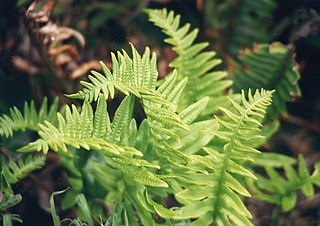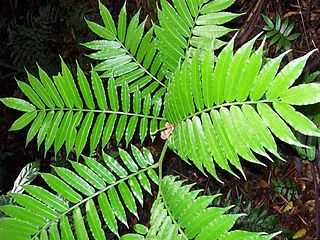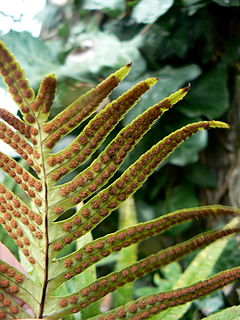
Pleopeltis polypodioides, also known as the resurrection fern, is a species of creeping, coarse-textured fern native to the Americas and Africa.

Phlebodium aureum is an epiphytic fern native to tropical and subtropical regions of the Americas. It is confined to the eastern side of the continents, extending north into the United States to Florida and the extreme southeast of Georgia, and south through the Caribbean, and northern and eastern South America to Paraguay. It is the only species of Phlebodium found in North America, the other species all confined to South America. Other common names include calaguala, laua`e haole (Hawaiian), samambaia (Portuguese), and hartassbräken (Swedish).

Phlebodium is a small genus of two to four species of ferns, native to tropical and subtropical regions of the Americas. The genus is closely related to Polypodium, and the species were formerly included in that genus.

Polypodium calirhiza is a species of fern in the polypody family. Its common names include nested polypody and habit polypody. It is found in California and Oregon in the U.S., and several states of Mexico: Colima, Jalisco, Mexico State, Oaxaca, and Veracruz. The leaflets on each leaf are broad and oval-shaped, coming to a dull point. This fern is sometimes epiphytic.

Grammitis is a genus of ferns in the family Polypodiaceae. It had formerly been placed in the family Grammitidaceae, but this family is no longer recognized by most authors because phylogenetic analyses of DNA sequences have shown that it is embedded in Polypodiaceae.

Polypodium glycyrrhiza, commonly known as licorice fern, many-footed fern, and sweet root, is a summer deciduous fern native to western North America, primarily in a narrow strip in southern Alaska, southwestern Yukon Territory, western British Columbia, Washington, Oregon, and California, though two highly disjunct populations are known from Idaho and Arizona. It thrives in a humid climate, prevailing in areas with cool and moist summers and warm and wet winters. P. glycyrrhiza can often be found growing on the trunks and branches of winter deciduous trees, particularly bigleaf maple, but is also often found on rocks, logs, and wet, mossy humus. It takes advantage of the mild, wet winters and the substrate of deciduous trees to photosynthesize and grow during the cold season when most other temperate plants are dormant. Habitat elevation is lowlands below 600 meters.

Microsorum pustulatum is a species of fern within the Polypodiaceae family. This species occurs widely in New Zealand and also in Queensland, New South Wales, Victoria and Tasmania in Australia. An example occurrence in the North Island of New Zealand is in the Hamilton Ecological District where it is associated with a number of other ferns including Blechnum filiforme and Blechnum discolor.

Polypodium appalachianum is a fern species native to eastern North America. Sometimes called the Appalachian polypody or Appalachian rockcap fern, it is very similar in appearance to Polypodium virginianum. For years, P. virginianum—long considered a variety of the British Polypodium vulgare—was recognized as having cryptic races, with diploid, triploid, and tetraploid representatives. Since the triploid specimens bore abortive spores, it was apparently the hybrid between the diploid and tetraploid groups. In 1991, it was resolved that the type of P. virginianum was the tetraploid series, and that it is an allotetraploid species of hybrid origin, with the diploid species as one parent. The diploid species was then named P. appalachianum. The other parent of P. virginianum was found to be Polypodium sibiricum. The tetraploid of hybrid derivation tolerates warmer climates than either parent.

Polypodium californicum is a species of fern known by the common name California polypody.

Polypodium hesperium is a species of fern known by the common name western polypody. It is native to western North America from British Columbia to California, and the Rocky Mountains to northern Mexico, where it grows in rocky habitat types.

Polypodium scouleri is a species of fern known by the common names leathery polypody, Scouler's polypody, coast polypody and leather-leaf fern. It is native to coastal western North America from British Columbia to Guadalupe Island off Baja California. It is a plant of the coastline, growing in cracks on coastal bluffs, in oceanside forests, beach dunes, and similar habitat. It is often affected by heavy fogs and sea spray. This polypody anchors with a waxy, scaly rhizome. It produces triangular or oblong leaves up to 85 centimeters in maximum length and 27 in width. Each leaf is made up of many round-tipped linear or oblong segments which are usually stiff and leathery in texture and edged with shallow, rounded teeth. The underside of each leaf segment is crowded with rounded sori each up to half a centimeter wide. The sori contain the spores.

Angiopteris evecta, commonly known as the giant fern, is a rare plant occurring in eastern and northern Australia and the Malay Peninsula. Also found growing in nearby islands such as Borneo, Sumatra, New Guinea and various places in Polynesia, Melanesia and Madagascar. Listed as endangered in New South Wales, where it has been recorded growing in sub tropical rainforest, in the valley of the Tweed River. It is an invasive species in Hawaii and Jamaica.

Polypodium cambricum, the southern polypody or Welsh polypody, is a species of fern in the family Polypodiaceae, native to southern and western Europe. It is a spreading, terrestrial, deciduous fern growing to 60 cm (24 in) tall, with pinnate fronds. The sori are yellow in winter.

Leather-leaf fern is a common name for several ferns and may refer to:

Polypodium australe is a plant in the Polypodiaceae family. The common polypody is medicinal plant known since the times of Dioscorides, and its rhizome is used against cough and liver diseases.

Polypodium is a genus of parasite attacking the eggs of sturgeon and similar fishes. It is one of few metazoans that lives inside the cells of other animals.















